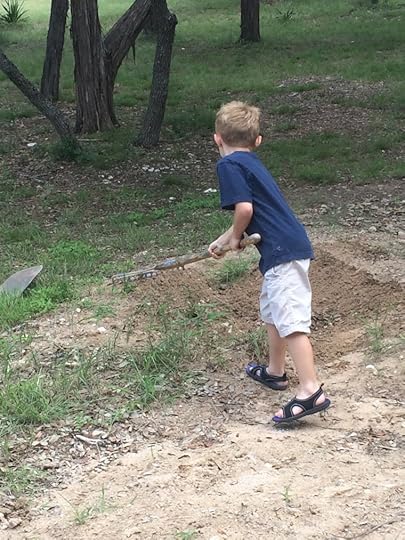Kenneth A. Camp's Blog, page 14
October 14, 2016
Here it Is! The Launch of My New Podcast!
His Hands His Feet Introduction Episode

I am excited to share with you the launch of my new podcast—His Hands His Feet. This has been in the works for several months and now here it is!
Here are the show notes:
Three objectives in today’s introduction episode.
A little of who I am.
Married for over 28 years.
Enjoy travel, mission work, and loving our our son that we adopted through foster care.
Been on many short term mission trips including living six months in Thailand as volunteer missionaries.
Live in the Austin, Texas area.
Professionally I have a background that includes project management, youth and missions pastor, serving on non profit boards, writer and blogger, and now a podcaster.
Content you can expect on future episodes:
Three main buckets.
Caring for those without a family. This is where foster care and adoption falls.
International missions.
Local ministry/non profits.
How I will share the content:
Interviews with foster and adoptive parents, experts in the foster care and adoption world, ministry and non profit leaders, and foreign missionaries.
Regular conversations with Danielle, my wife. These include adoptive parenting, mission work, and life in general.
Digging deeper into blog posts from my website, such as, 7 Things Your Foster or Adoptive Kid Needs to Hear from You.
Benefits to you:
Authentic stories and conversations that will inspire and encourage you to live a life on mission.
Tips and ideas.
A friend who is on this journey with you.
Please take a moment and go to iTunes to subscribe to my podcast then rate and review it. I appreciate that greatly.
You can get to this episode in iTunes here.
I want to hear from you so I can know who you are, what you want to hear, suggestions you have and so on. Please fill out the contact form below so I can hear from you.
[contact-form]
October 11, 2016
5 Ways A Life Is Defined by Generosity
What exactly does generosity mean? A readiness to give more of something, as money or time, than is strictly necessary or expected is one definition I like.

Some people live such a life of generosity that other people notice it. Even if a person is anonymous with their generosity, the right hand doesn’t know what the left hand is doing kind of generosity, people can still tell that that person is generous.
But what kind of lifestyle defines a generous person?
A generous person holds their possessions loosely.
This doesn’t mean that they don’t value what they own. That’s the point. They own their possessions. Their possessions don’t own them.
A generous person notices those around them who need help.
A generous person isn’t consumed with their own life to the extent that they walk right past someone in need without even seeing them. And not only do they notice, they respond.
A generous persons gives to others who can’t, or not easily, repay.
This includes more than a poor person. It is a child who needs a family. It is a widow who needs a relationship. A generous person never has an ulterior motive of getting something in return.
A generous person engages people who are different than themselves.
We all tend to gravitate to those who are like us. A generous person moves out his or her comfort zone and gets to know others who are of a different race, culture, or worldview. They take time to listen, understand, or learn the other person’s language. They might even move to where that person lives just so they can engage them more deeply.
A generous person builds margin into their lives.
Many want to live a generous life. At least they say they want to. But how they use their time and money reveals their true heart. A generous person intentionally assures that they have time and money available to invest in other people.
Do any of these characteristics define your life? If they do, I bet it didn’t happen by accident. Seldom does a person accidentally become a generous person. If a person leads a generous life most likely they made it a priority.
If anyone wants to live a missional or sent life, it will take living a generous life. They go hand in hand. Maybe you just had an epiphany. You have wanted to live a missional life, but it just never seems to happen. You have wanted to be more generous, but again, it just doesn’t happen. Something always seems to get in the way or you never have enough time or money to help someone else.
Here is a truth—Someone, somewhere needs you.
The question is will you make it a priority to live life in such a way that you own your possessions rather than them owning you, notice those in need, not expect anything in return, engage in people different than you, and build margin in your life?
When you do I am sure you will live a generous life.
Reminder! I will notify you when you can get a free copy of my next book—Foster and Adoptive Parenting: Authentic Stories that Will Inspire and Encourage Parenting with Connection.
If you want to get notification on when and how to get your free copy just click the button:
I want to get a free copy!
Please pass this information on to anyone you think might be interested in this book!
October 4, 2016
Sometimes It’s the Parent Who Needs to Regulate
Isn’t it a shock when you see yourself on video? Often we say, “I didn’t know I looked or sounded like that.” We aren’t aware of our tone, our posture, our facial expressions, or even how we communicate our emotions.

Part of self-awareness is recognizing that what we think or feel on the inside doesn’t always translate accurately through our voice, emotions, and actions. Or do they?
Remember Mister Rogers’ Neighborhood? I can hear him now singing his simple greeting song:
“It’s a beautiful day in this neighborhood. It’s a beautiful day for a neighbor. Could you be mine? Would you be mine?”
Hearing that song in my head calms me. He was always calm. Always smiling. Always pleasant.
How I wish I was more like that.
I remember when my son was about four years old, and I noticed him exploring my face when we talked or played, even when I corrected him. He still does this a lot. I think he is gauging to see how safe I am.
He looks to see how emotionally regulated I am. He notices my voice tone, volume, and cadence. He takes nonverbal cues from my facial expressions and body posture. How well I regulate my emotional state, tone of voice, and non-verbal cues can help or hinder my son’s ability to regulate himself.
Here is a reminder of some Parenting with Connection principles you may have learned:
Regulate your Emotional State – When your child is out of control, match his or her expressions without matching his emotions. This allows you to communicate to him or her that you understand what he or she is feeling while staying regulated yourself and helping them do the same.
If I don’t do this well, my son angrily yells at me, “You’re just making fun of me!” He especially does this if he is hurt or upset. I admit that my first reaction is one of two things. I either want to tell him to “Suck it up. You will be okay.” or I have to muffle a laugh, because sometimes he is really cute or funny.
Neither reaction matches his emotion, and he usually melts down further. However, if I do a good job of regulating my emotional state and matching his expressions, he feels comforted and understood.
Practice Total Voice Control (TVC) – Let’s just say I am terrible at this. I try to use a firm voice, and it comes out as harsh and stern. My son usually responds with fear. He either runs from me or he tries to fight me by hitting, kicking, or throwing something at me. His eyes will dilate and I can see the look of fear.
“Specifically, your voice, and how you use it, matters a great deal when responding to fear-driven responses from your child as well as dealing with misbehavior.” —Dr. Purvis
T stands for Tone – Learn the difference between a firm tone and a harsh tone. I think again about Mister Rogers. I should listen to him over and over until I get that calm yet firm sound in my voice along with a less scary face.
V stand for Volume – Notice the loudness or bigness of your voice when correcting. I spent years learning how to project my voice for singing. I use to joke with friends about having the nickname “Larry Loud.” I have silenced a roaring room of a few hundred without the use of a microphone more than once. That’s not exactly the volume I need to use when talking to my son though.
C stands for Cadence – Slowing the cadence grabs attention and avoids a harsh tone and a loud volume. I have noticed that both Danielle and I tend to talk faster when trying to correct or direct our son. It’s like I think I can accomplish this better if I can barrage him with more words or keep talking so he doesn’t have any airspace for a sassy or defiant comeback.
My son almost always regulates when I slow down my cadence, use a lower volume, and use an appropriate tone. I can visually see him able to respond to me with cognitive thinking rather than with a fear-based response.
Focus on Nonverbal Communication – Consider not only the words you use or don’t use but also your nonverbal signals. Is your posture relaxed and inviting or rigid and threatening?
It really would help if we always had a mirror in front of us especially when we interact with our kids. I know I wouldn’t like the reflection of my nonverbal communication.
I only know one way to do this well. I rarely am aware of my nonverbal cues in the moment of interaction with my son, especially if I react with big emotion. What helps me is to put a mirror up to my heart. My emotion, my tone, my nonverbal communications tend to follow the state of my heart.
Today’s blog is part of a chapter from my soon to be available book, Foster and Adoptive Parenting: Authentic Stories that Will Inspire and Encourage Parenting with Connection.
Want to know when you can get a free copy? Follow this link—Get a Free Copy!
September 26, 2016
Year Four Adoption Update
Hard to believe that it has been four years since we stood before the judge and adopted our son. The actual “Gotcha Day ” was September 21, 2012.

Working hard at the new house.
Our son isn’t old enough yet to fully understand what his gotcha day means, but this year I got to eat lunch with him at school. He is in kindergarten now, and it was Dads for lunch day at his school. I thought it was a great way to spend some time with him on this special day.
This past year was a year of transitions. Last September I had major surgery on my right ankle; we moved to a new home in January; our son graduated from a preschool that he had attended for three years; Danielle had surgery in May; and finally our son began kindergarten at a new school where he didn’t know anyone.
Whew. As you can imagine all of those events made life just a little interesting around our house.
Surgeries
When I had my surgery, my son wanted to know if I would ever be able to play with him again, especially things like jump on his trampoline and wrestle on the living room floor. I assured him that we would.

You might remember this picture. My son wasn’t sure what to think about his daddy not able to run and jump with him.
With Danielle’s surgery, he didn’t always remember that he couldn’t run and grab her or jump up and down on the bed. That’s a hard thing for an active five-year-old boy.
The two major changes—moving and starting a new school—took some time and creativity to navigate.
A New Home
After we made the offer on the new house, I took my son over to explore the 5 acres. I told him about the woods, trails, and cool tree house. So he was all for checking it out. When we got back into my truck, I asked him what he thought about the new place to which he responded with yelling and crying, “I don’t want to move! I like the house we have now!”



Just so that you know, he loves his new house now just in time for him to transfer his anxiety to the new school.



A New School
We tried different things to get him used to the idea of his new school. One Saturday I took him over to the school to play on the playground and walk around the outside of the school. He enjoyed exploring, but he didn’t have much to say about going to school there.
He didn’t talk about school at all. Instead he began planning his birthday party which is in October and our annual Thanksgiving trip to the beach. He even began packing for the beach trip.
Danielle and I knew he needed help processing the idea of a new school. but the things we tried didn’t seem to work. Then his occupational therapist suggested role playing. We decided to play out what it will be like the first few days at school.


He grabbed onto this idea and ran with it. As soon as he got home he “built” a kindergarten school in our living room. We took turns playing each role of child, parent, and teacher. This helped him to start talking about his fear of a new school.
What I Learned This Past Year
My son’s trauma history makes any transition unpredictable.
Role playing helps my son process transitions.
We need a year without any major transitions!
Here are a few other pics from this past year…





September 19, 2016
What I Have Learned So Far from Writing and Publishing My New Book
You probably know by now that I am close to publishing my next book—Foster and Adoptive Parenting: Authentic Stories that Will Inspire and Encourage Parenting with Connection. The ebook version is launching October 23, 2016 with the print version coming out Spring of 2017.

If you have thought about writing and publishing a book, I bet the how-to overwhelms you. It has overwhelmed me.
I share here a few pointers that I learned this go around both that helped my writing and publishing. I am just beginning the launch and promotion phase, so I will post a blog about what I learn from that soon.
What I learned about writing:
Mind map. Once I decided on the subject of my book, I spent a few days doing a mind map. The temptation is to begin writing. Instead I learned that it helps to get all the thoughts and ideas out of my head and on paper.
Group ideas together. Getting my ideas out on paper allowed me to easily see how ideas fit together. This also helped me to decide what didn’t belong in this book.
Outline. Now the outline began to fall into place. This isn’t the table of contents. Just an outline to help with the first rough draft.
Write like crazy. The time spent on the mind map and outline helped free me up to just write. The key at this stage was to write without paying attention to correct spelling or grammar. That comes later.
Mind map each chapter. As I began each chapter, I took about an hour or less to mind map that topic. This also helped me to write.
If you apply those simple tips, I am sure you can complete the rough draft of a 30,000 or so word book in a few weeks.
Now here are a few things I am learning about publishing:
Finding an editor. One of the most important steps for any book, especially a self published book, is editing. I learned two things about finding and working with an editor.
Interview the editor. I sent a sample page to about 10 editors. What they sent back to me allowed me to see their style and what they changed or corrected.
Ask for content and copy editing. The editor I hired agreed to send the manuscript back to me after she completed the content editing. Then we went through two rounds of copy editing. Be sure to make it clear what you want your editor to do before you hire them.
Note—I used Upwork to find my editor. A great tool to find free-lance professionals for many needs.
Importance of a good title and subtitle. A good title and subtitle tells a potential reader exactly what the book is about. (this is true for nonfiction)
Create a great book cover. I don’t have design skills, so I have to hire someone to do this. The main point is don’t cut this corner either.
Formatting the book for ebook and print. Just as with cover design, there are many ways to do this. If you know what you are doing, you can do it yourself. I use a couple of tools:
Scrivener. This is a writing tool that I highly recommend. It not only helps with the writing process but also helps when you get to the formatting stage.
Templates from Joel Friedlander at www.TheBookDesigner.com. These templates help save a lot of money and time.
If you are a writer or inspiring to be one, I hope these tips help. I enjoy encouraging others to write! Send me a note if you have questions about writing or publishing.
Also let me know if you want to be on my launch team for my new book. I will let you know when and how you can get a free copy.
One last note—Check out the Self Publishing School if you want help writing, publishing, and promoting your first book. (this is an affiliate link)
September 12, 2016
Is There Something In Your Life That You Need to Get Rid of?
Sometimes You Have to Dig It Out by the Roots
We had the same plant growing in every flower bed in our yard. The previous owners of our home apparently liked this plant. Even though it’s a pretty plant with either pink or purple petunia-like flowers that bloom each day, it’s incredibly invasive. It grows thick and tall, choking out or dwarfing the other plants in the bed.

So Danielle and I decided to remove most of the plants. I took a sharpshooter shovel and started digging in a flower bed in the front of the house. I quickly learned that the plant’s roots were tubular traveling underground with many plants growing from each cluster of roots.
We moved to the backyard flower beds, and we decided for the easier, quicker method—cut the plants off at ground level. We just wanted the flower beds to look better.
Both methods worked and the flower beds looked neat and uncluttered. For a few weeks anyway. Then it began to rain. And rain. One day I looked into the backyard and guess what I saw. The plants were growing again like crazy. I think they were growing back even thicker.
The flower beds in the front where I dug out the plants by the root? Only a few had poked back up above the ground.
Even though it’s much harder work, we knew what we needed to do. We needed to dig these guys out by their roots if we wanted to get them out of our flower beds.


I don’t think the previous owners had a devious plan for this plant to take over the entire yard, and maybe because it is a nice looking plant, they couldn’t bear to get rid of any of them.
In life, we do the same thing. We either intentionally bring something into our life, or we ignorantly allow it in. Many times it looks nice, and we enjoy it for a while.
We might not even notice how it begins to take over, if we ever do. It might even take another person to point out to us how something is dominating our thoughts and actions possibly choking out other important things.
If we decide it’s time to do something about it, we often approach it like we did at first with the plants in our yard—we only cut back on it. We don’t remove it completely from our lives. We don’t want that. We just want to manage it.
Do you know or think you have something in your life like this? Or has someone told you that you do, but you keep blowing them off?
Maybe it is time to do the hard work of digging it out by its roots. Usually the hardest thing to do is get started when you know the work can be hard. Here is a secret—it’s not always as hard as you think it is.
Here are 4 things to do to get started on the work of digging out of your life that needs to be removed by its roots:
Stop ignoring it. Pretending that it doesn’t exist or that it’s not that bad will only delay the hard work. The first thing we have to do is take an honest look at what it is that is taking over and possibly ruining our life.
Don’t settle for the easy way out. If this habit, relationship, addiction—whatever it is—really is taking over your life, then it will take doing some hard work of digging it out by its roots. You need to do what it takes to remove it from your life.
Understand it will take time. Both when I do work like digging out plants in the flower beds and making needed changes, I always wish I could get the work done in one big effort—I prefer all in one day! However, usually work like this takes time; sometimes getting a little done each day over many days is best.
Allow others to help. Allowing others to help can take many forms. It begins with vulnerable, authentic sharing with a trusted person(s). This might be a spouse, a close friend, or a counselor.
If you know you have some work to do, I hope this encourages you to not put it off or try to short cut the work. It takes a courageous person to do the hard work of digging out things that need removed from our life by its roots.
Email me if you want to talk further about what you are facing and want some encouragement to get started on it today.
[contact-form]
September 5, 2016
Have We Changed What It Means to Be a Disciple?
3 Ways We Have Lowered the Bar for Discipleship
When I say “We” I refer to the church. I count myself in that clan. I grew up going to church every Sunday. Our family attended church Sunday morning, Sunday night, Wednesday night, and any other time something was going on at the church.

That wasn’t a negative thing for me. It was my extended family. We did a lot of life together with other families. Many Godly men and women influenced my life in positive ways.
Looking back I recognize something that has become engrained in today’s church culture. It’s the idea that once a person “prays a prayer” of salvation, the job is complete. Now just keep hanging around the church, and you will be okay.
I prayed a “prayer of salvation” at the age of seven. I have a Bible with the date written in my own seven-year-old handwriting in the front cover. I found the Bible on my bookshelf. Take a look!


I have to admit that’s stinking cute.
But have we changed what it means to be a disciple?
What is Discipleship?
When I say “discipleship”, I mean “teaching a new believer how to follow Jesus Christ.”
The best way I know to disciples another person is by doing life together. Eating, working, playing. Knowing, disagreeing, forgiving. That is hard to do if we see each other for only 2-3 hours a week. And especially if those few hours are spent in some kind of classroom environment.
Don’t get me wrong, I enjoy the intellectual study of what it means to be a follower of Christ. And on occasion my life is changed after a discussion in a Bible study or listening to a sermon.
But when you add to that living alongside other believers in consistent, authentic community, discipleship truly happens. What it looks like to follow Christ daily is modeled.
How do I relate to my spouse and my kids as a Christ follower? What does it look like in my vocation? What about when life is challenging? How does a follower of Jesus Christ interact with the world around him or her?
It’s one thing to learn the ways of Jesus in a classroom, listening to a preacher along with a few hundred others, or even over a cup of coffee. But it’s a whole other thing to learn His ways when we are in the midst of living life with other Christ followers.
I think the reason this isn’t a priority in many churches today is because we have lowered the bar of what it means to be a disciple of Christ.
How have we lowered that bar?
We put a focus on “praying the prayer.” I know that moment of decision is important. We all have to make it sooner or later whether we will follow Jesus Christ. But I think it’s more of a process than it is a moment in time. We become followers of Christ. Even if we do have a date written inside the front cover of our Bible. What is as equally important, if not more so, is if someone teaches us by modeling a life with Jesus life written on the inside of their heart.
We equate church attendance to following Jesus Christ. A lot of good things happen at church. Or at least they should. Fellowship. Bible study. Worship. Service. The challenge is that if we over-emphasize church attendance, we model and teach a segmented life. This is how you live when you are at church and with church friends. And that is how you live when you are everywhere else; home, work, school, at play. That creates good church attenders, not necessarily disciples.
We lack authentic, life-on-life community. Unless you have found a smaller group of people within your church that you can live life with, attendance at church once or twice a week at the most, will not make disciples. How many of your church friends are you close enough to that you feel comfortable just dropping by their home or them dropping in on you at your home? If you feel like you have to spend a couple of hours cleaning your house before anyone comes over then you don’t have any friends like that.
Raising the bar of discipleship.
Raising the bar of discipleship isn’t a painful process. It is an intentional shift in the way we live our lives.
It will take rearranging priorities. Yes, you will have to remove some things from your schedule.
It will mean allowing others to really know you. I can look like the perfect husband and father to those I go to church with each week for a couple of hours. But if they do more life with me, they will see me also when I blow it.
It will have immediate opportunities to apply what you learn about following Jesus Christ. Rather than intellectual knowledge that is easily stored away until the next Bible study, a disciple applies what he or she learns to every facet of their life.
Will you take a look at your life along with me and see where we need to return to what God calls a disciple?
August 30, 2016
Why Can’t We Tell Our Kids “Yes”?
I get really good at saying no. I can say it kindly, with force, in rapid succession, with anticipation of the question, and even without looking. In my mind, I always have a good reason for telling my son no. I don’t want him to do that, eat those, or bother me at the moment.

I think I should invent an app kind of like the ones that record every step you take so you can see how many miles you incidentally walked in a day. Except this app records every time you say no to your child. On second thought, I don’t think I want to know.
Why is it so hard for me to just say it. Just Say Yes.
I think I know why. I am afraid if I say Yes too much it will ruin my son. Won’t he end up thinking that he can have anything he wants, do everything he wants to do, and never have to wait his turn?
When A Child Needs To Hear No
Of course sometimes we need to tell our children “No”. This goes back to the proper balance of nurture and structure. It’s our responsibility to keep our children safe, to make sure they get good nutrition, and learn to make good choices.
However, what I can learn to do better is how to say No in a way that still nurtures instead of in a way that squelches my son’s spirit, comes across as a punishment, or even causes fear.
I can say “no” with playful interaction, immediate praise for a good response, and with a kind voice and facial expression.
Once again, if my goal is behavior modification and not connection along with a longterm result, then saying no with disregard to how often and how I say it will work fine.
Daddy or Mommy Yes Days
So what are these Daddy and Mommy Yes days?
We decided to offset the amount of times we say no to our son by having, on occasion, a day where we would say yes to any and every reasonable request our son made. These work well when it is a day when one of us is with him most of the day, and we don’t have any set plans.
“Can I watch another TV show?’ “Sure, just one more.”
“Can we go to a park?” “You bet! We will go for a few minutes on our way to the store.”
“Daddy, I want pizza for lunch!” “Sounds good to me!”
“Can you play this game with me?’ “Can we read books?” “Can I have another treat?”
“Yes, yes, and yes.”
After a Daddy yes day, I know why I sometimes say “no” more often than “yes”. It is easier, less time-consuming, and not as exhausting.
It also takes more creativity on my part to think of ways to say yes, especially yes to things I am okay with approving. I will slow my response down a few seconds to ask myself, “Is there any reason I can’t or don’t want to say yes to this request?” If I can’t think of a good reason, then it’s “Yes!”
As you can imagine, our son loves these days! From time to time he asks, “Can today be a Daddy Yes day?” Now how can I say “No” to that cute face!
Two things happen when we have a Daddy Yes day. First, I recognize how I often I say “no” just because. And, my son and I connect more because I enter his world, I hear his requests, I give him voice, and so on.
Today’s blog is an excerpt from my upcoming book for foster and adoptive parents. Want to be a part of the pre-launch team? Click here to get on the team. You will get updates, find out when you can snag a free copy, and so on!
August 23, 2016
5 Mistakes We Make When We “Help” The Poor
You volunteer along with many others to help make some repairs at a family’s home one Saturday. You end up sitting on the front porch listening to the mother’s story. She shares her stress over mounting medical bills that keeps her awake at night.

You decide to spend several hundred dollars to fly to the other side of the world to spend a week working with a mission organization. You get to know a few of the local people who work along the missionaries. At a meal, you sit by one local who shares with you their passion for the work they are doing among their own people. Within the conversation you learn that they need more financial support.
You have a compassionate heart. That is why you invest your time, money and energy into helping others. And their stories tug at your heart-strings. We look at our financial means, and we want to help. We “know” we can help out of our abundance.
However, our good intentions to help those “less fortunate” than ourselves can cause more harm. In my work with local nonprofits and with international missions, I have seen 3 main mistakes made when we try to help the poor.
First, understand I have made many of these mistakes too. Our perspective is just that, our perspective. We can only understand or make sense of the world around us through our lens of experience influenced some by gained knowledge.
We assume we understand the story. In our attempt to make sense of another person’s life, we jump to conclusions about their situation and the remedy. We get caught in a moment of time..that day we sit with them on their porch…that week that we serve on a mission team in another country. In our attempt to “fix” the problem, we think we need to act as soon as possible.
We don’t check with those who does know the story. Almost always someone is closer to the situation than we are. I don’t know why we ignore their insight, but often we do. We can avoid causing more pain simply by having a conversation with a the project/ministry leader or the missionary.
We lack an understanding of their culture. I have been on many short-term mission trips to countries all over the world. What I notice about myself, is that my mind is on overdrive taking in everything around me. My mind is trying to make sense of what it is observing. Without any conscious prompting, I make conclusions about what is true and not true about this culture that I am experiencing for maybe the first time.
I laugh when I or others spend one week in another country and based on our experiences, we proclaim, “this is how they do it in Thailand or Guatemala, or China…”.
This is true for our interaction with others that live close to home. We think that just because we live within 3o minutes of each other that we approach life the same way; that we have the same cultural standards and expectations. Nothing is farther from the truth.
Our perception of success is different. As we listen or see someone’s situation, we often begin to look for solutions. We often think that money is what will meet the need. Is it possible that the person is sharing their needs with you, because they need someone to listen? Or maybe they need someone to give them advice?
I have sat with a homeless friend of mine at lunch more than once. The only thing I did was listen and pay for lunch. I didn’t try to get him off the streets. I didn’t give him money for anything. I listened to him as a friend. I still see him from time to time standing on a street corner asking for money. When he sees me, he smiles and waves.
What he needed more than the money was a friend.
We respond from a “god-complex”. We think that because we have more financial resources, even if by our standards we feel poor, we think that this will solve all the “poor” persons problem. What we neglect is that God is ultimately in control, and He is working in this person’s life. He has been long before we show up on the scene.
We are responding from our own need for significance. This need clouds our best judgement. We end up causing more harm than good, and we make commitments that later we regret.
What do you do now?
I hope you continue to respond with compassion! I also hight recommend this book if you haven’t ever read it:
When Helping Hurts: How to Alleviate Poverty Without Hurting the Poor . . . and Yourself
This book influences many of my thoughts in this blog. Also, visit The Chalmers Center which goes deeper into how you can help others without harming them or yourself.
Do you have a story to share? I want to hear it! Leave it in the comments below.
August 15, 2016
Why Giving Your Child A Voice Is Important
A few weeks ago I posted a blog, 15 Ways We Shame Our Children. The first in the list—We don’t give them a voice. I realize that you might not know what it means to “give a child a voice”. It’s important for any child to discover their voice. This usually happens in healthy families. But for kids that come to us from a hard place, it’s a struggle.

The rest of this blog is a chapter from my upcoming book. I am still working on the title, but it’s a book for foster and adoptive parents wanting to apply parenting with connection principles and need encouragement and real life examples of failure and success.
What Is ‘Giving Voice’?
Most of our kids that come to us through foster care or adoption, no matter what age, haven’t been given a voice.
Babies that get no response to their cries learn to not cry anymore. A toddler learns to meet their own needs as best they can which is why we often say they are “street smart”. Teenagers revert to manipulation as they try to get their needs met.
All are examples of a child with no voice.
One of the powerful ways we as parents can empower and help our children feel safe and heal from trauma is to give them a voice.
Our son was, as you know by now, eight-months-old when CPS placed him with us. Like any baby, he cried, screamed, and yelled when he was hungry, wet, alone, or afraid. We immediately responded. Even if it was over and over.
He definitely used his voice. That tells me that at least someone responded to him before he came to us.
If you adopted a child that spent time in an orphanage, you might have noticed he or she doesn’t cry much, maybe not at all. You can find many stories of people shocked by how quiet a room full of babies are in many orphanages. We expect to hear crying, even wailing, when we enter a room full of babies.
But what happens when no one responds to a babies cry? It doesn’t take very long for that baby to stop crying.
We want to hear our babies cry!
Our son now talks from the moment he wakes up until he goes to bed. I am an introvert. And Danielle and I didn’t have to share airspace with anyone in our home for over 20 years. So, my first reaction many times is to ask him to be quiet. I know!
Not only I tend to get offended when I don’t have any room for my own voice, I don’t do a good job of fully listening to my son. Often he does this, “Hey dad look at this”, then he looks at me to see if I am looking at it. If I am not, he says, “Dad, dad, dad…look at this!” So I look at him, and while he is telling me what he wants me to hear, he keeps glancing at me to see if I am still fully listening.
I have made note of this, because it communicates to me that he doesn’t feel that I hear him.
Why Having A Voice Is Important
I know for some cultures it is taught that children should be seen and not heard. That sounds nice to my selfish ears. But it doesn’t promote healthy, connected children. Nor does total chaotic kid anarchy either!
When I give my son a voice he learns that:
He Is Safe. One common theme of my son, and for a lot of trauma kids, is “fighting bad guys”. We talk about this a lot. Every time I listen, maybe even play it out with him, and I always reassure that mine and Danielle’s job is to protect him. I tell him he doesn’t need to worry about bad guys. I encourage him to enjoy all the fun things that five-year-old boys are meant to enjoy.
It’s Okay To Have Needs and Wants. Needs and wants don’t go away after we are a baby. We have them for the rest of our lives. Trouble is that many of us don’t ever learn how to express these in healthy ways. When I let my son voice his needs and wants, he learns that it’s okay to have them. He also learns that I am willing to listen to them. And, when I can and it’s appropriate, I want to help meet them.
He Doesn’t Have To Demand. The more voice I give him, and the better I listen, the less my son tries to control, manipulate, or triangulate in order to be heard. He also gets angry much less resulting in fewer tantrums and meltdowns.
How Can I Give Voice To My Child?
First, I have to understand the importance of giving my son a voice, and how that helps us connect. Honestly, I need reminding of that truth often.
Second, I need to remember that I am an adult with years of experience, and my son is experiencing many things for the first time. He needs to express! And I need to learn to listen.
I probably even need to learn how to hear my son’s distinct voice. What does that tone; that cry; that laugh mean?
Physically and emotionally I can give my son voice by stopping what I am doing, when I can, looking him in his eyes, even lightly touching him on his arm or cheek, and listening to him. This takes me being fully present with him.
When I am able to give my son his voice, he feels valued, loved, and connected. That is empowering. And when I need to correct, he is more likely to receive the correction.
Empowering our child by giving him or her a voice can intimidate any parent. What if they have questions I don’t want or know how to answer? What about thoughts that I am uncomfortable discussing? And what in the world do I do with emotions?
I struggle with my own questions, thoughts, and emotions, much those of a little person who comes from a hard place. But one huge way I can give my son voice is by helping him express his feelings. And chances are any child from a hard place will have HUGE feelings.
If you want to get all the pre-launch information about my upcoming book, go here. But hurry! The launch date is in mid-October.



